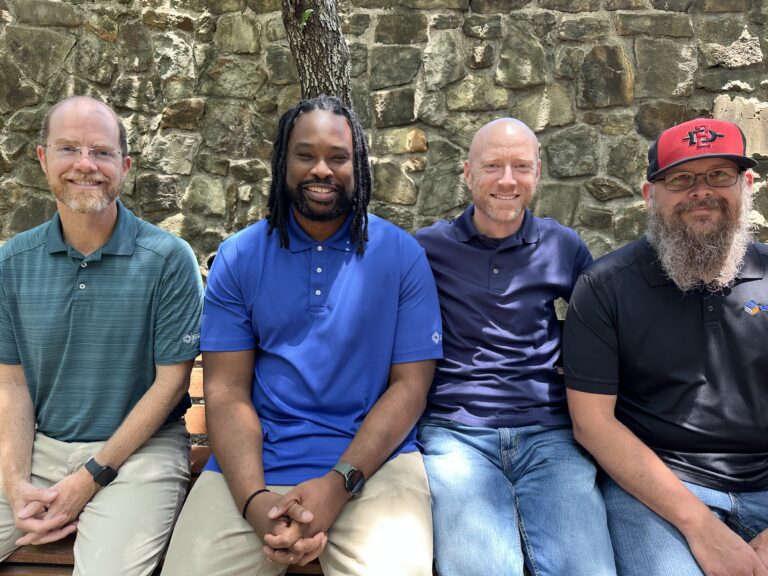At EEA, much of our success lies in the expertise and passion of our technical team. From designing energy-efficient mechanical systems and next-generation electrical infrastructure to streamlining BIM workflows and pioneering water-wise plumbing solutions, these professionals ensure every project delivers both performance and sustainability. We caught up with four of our team leads to dig into why their disciplines matter, how their work creates long-term value for clients, and which emerging trends have them most excited. Below, Jeremy, Mike, Tyrone, and Kelsey share their insights in a quick Q&A.

EEA’s Technical Team consists of:
- Jeremy Smith, PE, LEED AP – Chief Technical Officer
- Tyrone Thompson – Building Information Modeling (BIM) Manager
- Mike Gath, PE, LEED AP – Principal, Electrical Engineering
- Kelsey O’Connor, CPD – Plumbing Design Manager
Why is this type of work important from a technical perspective?
Jeremy: The mechanical systems are a significant portion of the energy consumption for a building. They are also one of the first places a design team goes to when looking for energy savings opportunities. I continue to be motivated to engineer buildings to be a simple as possible for owners to operate. It doesn’t matter how efficient the design may be on paper if the occupants don’t understand it! They often will circumvent the controls until they do understand it which isn’t good. In my role of CTO I review hundreds of deliverables per year where I help product the highest quality product possible with a focus on simple and sustainable controls.
Mike: One of the latest industry shifts is the elimination of non-renewable energy sources for heating. The 2024 IECC requires the electrical design to have infrastructure in place for any future gas to electric conversions. In addition, the latest IECC requires the generation (and future storage) of on-site renewable energy. These new requirements are making the electrical design more important than ever. Additionally, LED lighting is becoming mandatory with the phasing out of fluorescent lighting and the allowed watts/square foot densities always on the decline.
Tyrone: We create clear standards and processes so that everyone—from production to project manager—can use the models easily and confidently. That means fewer surprises during construction, smoother collaboration between disciplines, and more accurate project information from start to finish.
Kelsey: The plumbing systems are a large consumer of water in the building. Water efficiency has become a major issue in many of the southwest states. Water capture and reuse is becoming the normal for plumbing systems and keeping these systems as simple as possible for ease of use by the owner has become imperative. Understanding new technologies in the plumbing world to reduce natural gas consumption.
How does this work deliver long-term value for clients?
Jeremy: As mentioned above, simple and easily understood controls will almost always result in the best outcome for comfort AND energy conservation.
Mike: Even though LED lighting is 30%+ more efficient than fluorescent lighting (and 90% more efficient than incandescent), the code is still acting like Dad by always turning lights off for you. As the cost of energy is going up, any watt not used is savings to the client in their yearly operational budget. In addition, LEDs can last up to 25 years which has huge operational benefits by not having to re-lamp fluorescent bulbs that lasted 2-4 years.
Tyrone: By staying up to date on industry trends and emerging technologies, we’re able to guide our clients toward the most effective solutions—not just for today’s needs, but for what’s coming next. Whether it’s model-based coordination, or cloud collaboration, we make sure your project is aligned with where the industry is heading.
What trends or technologies is your team excited about pursuing in future projects?
Jeremy: I am particularly excited about immersion cooling in data centers where the servers are immersed in a fluid tank. From an energy efficiency perspective, it has huge potential!
Mike: Smarter building controls are on the horizon. Lighting occupancy sensors will now communicate to the HVAC to allow unoccupied spaces to not be over conditioned. This could yield huge energy savings for those buildings that are lightly occupied during days when most work from home.
Tyrone: Cloud platforms like Autodesk Construction Cloud are changing how teams share and coordinate models in real time. This helps keep everyone aligned, even across multiple offices or project partners. Internally developed Revit add-ins are helping us automate repetitive tasks, reduce errors, and focus more on design quality.
Kelsey: Storm drain capture, gray water and black water reuse systems to reduce water consumption, heat pump water heating systems to reduce natural gas/electrical needs.